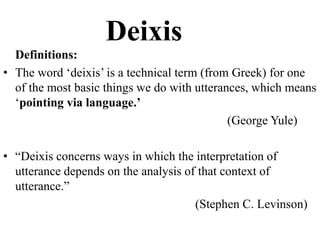deixis-and-distance
- 1. DEIXIS AND DISTANCE by Kulsoom Mushtaq
- 2. Deixis Definitions: • The word ‘deixis’ is a technical term (from Greek) for one of the most basic things we do with utterances, which means ‘pointing via language.’ (George Yule) • “Deixis concerns ways in which the interpretation of utterance depends on the analysis of that context of utterance.” (Stephen C. Levinson)
- 3. Deixis is any word that cannot be interpreted without reference to physical context: the speaker, addressee, time, and place of utterance. For Example: you’ll have to bring that back tomorrow, because they aren’t there now. • Out of context, this sentence is extremely vague. It contains a larger number of expressions (you, that, tomorrow, they, here, now) which depend for their interpretation on the immediate physical context in which they were uttered.
- 4. These cannot be understood in terms of speaker’s intended meaning. These are technically known as deictic expressions.
- 5. Deictic Expression • Any linguistic form used to accomplish ‘pointing’ is called a deictic expression. • Deictic expressions are also known as indexicals.
- 6. Deictic Expression • Deictic expressions are meaningful in a given context. • They are among the first words acquired by children. • In order to be interpreted correctly, the speaker and listener have to share the same context. • They are particularly useful in face to face communication.
- 7. Deictic Expression • What are the deictic expressions in the following utterance? I’m busy now you can’t do that here. Come back tomorrow.
- 8. Types of Deixis • Person Deixis: any expression used to point to a person (me, you, him, them) is an example of PERSON DEIXIS. • Space/Spatial/Place Deixis: words used to point to a location (here, there) are examples of Place Deixis. • Time/Temporal Deixis: the expression used to a time (now, then, tonight, last week, yesterday) are examples of Time Deixis.
- 9. Person Deixis • Person deixis operates on a basis three-part division, exemplified by the pronouns for first person (‘I’), second person (‘you’), and third person (‘he, she, it’). • A speech event includes at least two persons: - first person = speaker - second person = addressee • Usually the third person is not grammatically marked, because the only two persons of importance are the first person and the second person.
- 10. Person Deixis • Pronouns: All languages have personal pronouns or at least words, that refer to the participants of the speech act. • The pronouns of the first (I-my-mine) and second person (you-your-yours) are deictic (reference to the speaking person).
- 11. • It is also possible to have deictic pronouns for the third person. • Definite and specific pronouns: this, that, those, or these. • Indefinite and specific pronouns: somebody, something, who, what. • Indefinite and non-specific pronouns: someone, something, nobody, nothing.
- 12. SOCIAL DEIXIS: forms used to indicate relative social status. In many languages deictic categories become markers of relative social status. HONORIFICS: expressions that mark that the addressee is of higher status. SOCIAL DEIXIS
- 13. Examples of SOCIAL DEIXIS In Spanish the “Tú”- “Usted” distinction. • The choice of one form will communicate something, not directly said, about the speaker’s view of his relation with the addressee. • The higher, older and more powerful speaker will tend to use the “tú” and viceversa. • Nowadays, the age distinction remains more powerful than the economic distinction in many countries.
- 14. Using the 3rd person form • Communicates distance and non-familiarity. Also, it has an ironic or humorous purpose. i.e: Would his highness like some coffee? • Also used to make accusations: “Somebody didn’t clean up after himself” (less direct than “You didn’t clean”
- 15. Space/Spatial/Place Deixis • The concept of distance is relevant to spatial deixis, where the relative location of people and things is being indicated. • Some pure place-deictic words: here and there (adverbs); this and that (demonstrative pronouns). • Here = (near); there = (more distant) • Demonstrative pronouns: This = the object in a pragmatically given area close to the speaker’s location. That = the object beyond the pragmatically given area close to the speaker’s location.
- 16. Ex: I’m writing to say I’m having a marvelous time here. (includes the location of speaker) Bring that here and take this there. (away from the location of speaker)
- 17. • Motion verbs: come vs. go makes distinction between the direction of motion. • She’s coming = she is moving towards the speaker’s location. • She’s going = she is moving away from the speaker’s location. • I’m coming = the speaker is moving towards the location of the addressee.
- 18. Time deixis Expressions referring to time: five minutes ago tomorrow last week next Monday Choice of tense: • present tense : He doesn’t know. (this is nearer to the point of reference) • past tense: Yesterday I slept for 10 hours (this communicates distance from current time)
- 19. • Conditionals if I won the lottery I would … (this communicates distance from current reality) • Time Deixis is relevant to various other deictic elements in language: Ex: • Greetings: Good morning (can only be used in the morning) • Expressions: the former president, my ex-roommate
- 20. DEIXIS AND GRAMMAR The distinctions for person, spatial, and temporal deixis can be seen at work in English grammar structures such as DIRECT and INDIRECT (reported)SPEECH. i.e: Are you planning to be here this evening? – I asked her.
- 21. REPORTED FORM • I asked her if she was planing to be there that evening There’ s a shift from the “near speaker” meaning of direct speech to the “away from speaker” meaning of reported speech, with the use of DISTAL DEICTIC forms.





















